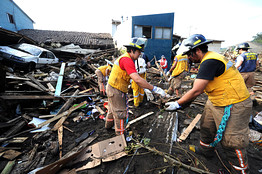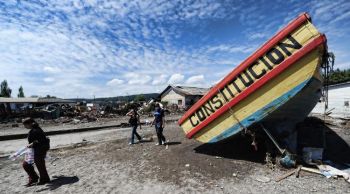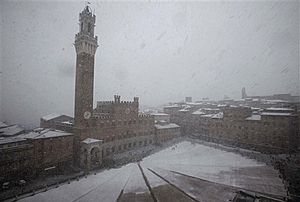
"This is an esoteric effect that physics says has to happen," notes David Kerridge, the British Geological Survey's head of natural hazards, who studies earthquakes. "It's interesting, but it has no particular consequence on anything."


Professor Rainer Kind from the German Research Centre for Geosciences (GFZ) in Potsdam said: "It is highly doubtful that these calculations are correct. The changes to the Earth's axis caused by an earthquake would be so tiny that it isn't measurable and therefore impossible to reliably detect."So while a strong earthquake may not be sufficient to shift the planet's axis and thus alter the length of days, it's conceivable that a change in the arrangement of "the heavenly bodies" might well do so. The good professor probably didn't have this in mind when he used that term, but if we consider that comets and their debris trails are also "heavenly bodies", then we can see that earthquakes may be a symptom of an external cosmic force affecting Earth's rotation. Any slowing down of rotation, however imperceptible, would be sufficient to affect the magnetic field and produce incredible pressures within the planet that then shift tectonic plates, resulting in more earthquakes and volcanic eruptions as that pressure is released.
Existing calculations of the movement of the Earth's axis by past earthquakes are still being debated, the expert added.
Professor Karl-Heinz Glassmeier from the Deutschen Geophysikalischen Gesellschaft (German Geophysical Association) also criticised the alleged discovery: "I hit my hand on my head as I read that yesterday.
"NASA can only make the headlines with it. A figure of eight centimetres is absolutely unverifiable."
The influence of an earthquake on the Earth's tilt would in any case be extremely low, explained Dr. Mojib Latif from The Leibniz Institute of Marine Sciences in Kiel.
He said: "The heavenly bodies around us are mainly responsible for the Earth's tilt. The gravity of the heavy and big planets in particular determines the gradient of the Earth's axis.
"That can not be changed by an earthquake, even one as powerful as that in Chile."
Professor Kind added: "It is impossible that there could ever be such a severe earthquake which would observably move the Earth's axis. That would only be possible through outside influences, for example a meteorite.
"The destruction however would be so great, that the movement of the Earth's axis would be comparatively insignificant."
New Moore Island in the Sunderbans has been completely submerged.From the New York Daily News via Associated Press reports :
New Moore Island in the Sunderbans has been completely submerged. Photo - Das/AP
Global warming resolves 30-year land dispute between India, Bangladesh: Coveted island sinksNote in the map below that the island was a river estuary, meaning it wasn't made out of rock as claimed. It was made out of mud and sand. From Wikipedia:
By NIRMALA GEORGE, Associated Press Writer Nirmala George, Associated Press Writer - Wed Mar 24, 9:29 am ET
NEW DELHI - For nearly 30 years, India and Bangladesh have argued over control of a tiny rock island in the Bay of Bengal. Now rising sea levels have resolved the dispute for them: the island's gone.
New Moore Island in the Sunderbans has been completely submerged, said oceanographer Sugata Hazra, a professor at Jadavpur University in Calcutta. Its disappearance has been confirmed by satellite imagery and sea patrols, he said. "What these two countries could not achieve from years of talking, has been resolved by global warming," said Hazra.
The island was situated only two kilometers from the mouth of the Hariabhanga River. The emergence of the island was first discovered by an American satellite in 1974 that showed the island to have an area of 2,500 sq meters (27,000 sq ft). Later, various remote sensing surveys showed that the island had expanded gradually to an area of about 10,000 sq meters (110,000 sq ft) at low tide, including a number of ordinarily submerged shoals. The highest elevation of the island had never exceeded two meters above sea level. [1]
...
The island was claimed by both Bangladesh and India, although neither country established any permanent settlement there because of the island's geographical instability. India had reportedly hoisted the Indian flag on South Talpatti in 1981 and established a temporary base of Border Security Forces (BSF) on the island, regularly visiting with naval gunships. [3][4]


Comment: NASA scientists claimed the Chilean earthquake shifted the Earth's axis by "2.7 milliarcseconds (about 8 centimeters or 3 inches)" and shortened the day by "1.26 microseconds (millionths of a second)". Just one strong quake, imagine! But the claim was countered as unverifiable and ludicrous by German scientists: So while a strong earthquake may not be sufficient to shift the planet's axis and thus alter the length of days, it's conceivable that a change in the arrangement of "the heavenly bodies" might well do so. The good professor probably didn't have this in mind when he used that term, but if we consider that comets and their debris trails are also "heavenly bodies", then we can see that earthquakes may be a symptom of an external cosmic force affecting Earth's rotation. Any slowing down of rotation, however imperceptible, would be sufficient to affect the magnetic field and produce incredible pressures within the planet that then shift tectonic plates, resulting in more earthquakes and volcanic eruptions as that pressure is released.